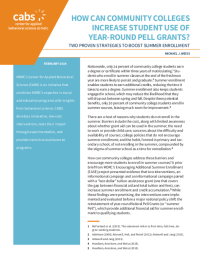How Can Community Colleges Increase Student Use of Year-Round Pell Grants?
Two Proven Strategies to Boost Summer Enrollment

Nationwide, only 24 percent of community college students earn a degree or certificate within three years of matriculating. Students who enroll in summer classes at the end of the freshman year are more likely to persist and graduate. Summer enrollment enables students to earn additional credits, reducing the time it takes to earn a degree. Summer enrollment also keeps students engaged in school, which may reduce the likelihood that they will drop out between spring and fall. Despite these potential benefits, only 30 percent of community college students enroll in summer courses, leaving much room for improvement.
How can community colleges encourage more students to enroll in summer courses? A prior brief from MDRC’s Encouraging Additional Summer Enrollment (EASE) project presented evidence that two interventions, an informational campaign and an informational campaign paired with a “last-dollar” tuition assistance grant (one that covers the gap between financial aid and total tuition and fees), can increase summer enrollment and credit accumulation. While these findings were promising, the interventions were implemented and evaluated before a major national policy shift: the reinstatement of year-round federal Pell Grants (or “summer Pell”), which provide additional financial aid for summer enrollment to qualifying students.
This brief supplements the prior one in several important ways. First, the EASE project has expanded from 4 colleges and 3,700 students to include 10 Ohio community colleges and over 10,000 students. Second, the interventions have now been implemented in two substantially different policy contexts, enabling an assessment of whether these interventions are robust to the shift in Pell Grant policy. Finally, for the first cohort of study participants it is now possible to determine the interventions’ effects on enrollment in the summer of their sophomore year.
The positive, statistically significant effects on summer enrollment and credit accumulation persisted after the federal policy change. In addition, a second year of the informational campaign plus tuition assistance (but not the informational campaign alone) increased summer enrollment and credits earned in the sophomore year for the first cohort of students. Neither intervention increased overall enrollment in the fall term.






